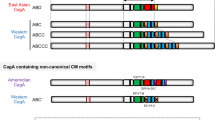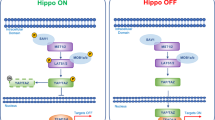Abstract
The cyclin-dependent kinase (CDK) inhibitor p27 has an important role in cell cycle regulation. Reduced expression of p27 is commonly associated with poor prognosis in many malignancies, including gastric cancer. Cytoplasmic p27 mislocalization may be an additional indicator of high-grade tumors and poor prognosis in cancer. As chronic infection by Helicobacter pylori is the most important risk factor for gastric cancer development, we evaluated the effects of H. pylori on p27 expression and localization in gastric cancer cells. Co-culture of gastric cells with H. pylori induced cytoplasmic p27 expression and reduced nuclear p27 expression in vitro. Cytoplasmic p27 expression was associated with and dependent upon phosphorylation of p27 at T157 and T198: wild-type p27 accumulated in the cytoplasm, but non-phosphorylatable mutants affecting T157 or T198 were nuclear in H. pylori-infected cells. These post-translational p27 changes were secondary to activation of cellular phosphoinositide-3 kinase (PI3K) and AKT signaling pathways, and dependent upon a functional H. pylori cag pathogenicity island. We investigated the clinical significance of cytoplasmic p27 mislocalization in 164 cases of resected gastric cancer in tissue microarrays. In 97 cases (59%), cytoplasmic p27 mislocalization was observed, and this was associated with increased mortality in multivariate analysis. These results show that H. pylori infection induces AKT/PI3K-mediated phosphorylation of p27 at T157 and T198 to cause cytoplasmic p27 mislocalization in gastric cancer, and that p27 mislocalization is an adverse prognostic feature in gastric cancer. This is the first demonstration of the translocation of a specific bacterial virulence factor that post-translationally regulates a host cell CDK inhibitor. This is of particular significance, because p27 has both tumor-suppressive and oncogenic activities, depending upon its subcellular localization. Cytoplasmic mislocalization of p27 induced by H. pylori may be an important mechanistic link between H. pylori infection and gastric carcinogenesis.
This is a preview of subscription content, access via your institution
Access options
Subscribe to this journal
Receive 50 print issues and online access
$259.00 per year
only $5.18 per issue
Buy this article
- Purchase on Springer Link
- Instant access to full article PDF
Prices may be subject to local taxes which are calculated during checkout






Similar content being viewed by others
References
Besson A, Gurian-West M, Schmidt A, Hall A, Roberts JM . (2004). p27Kip1 modulates cell migration through the regulation of RhoA activation. Genes Dev 18: 862–876.
Besson A, Hwang HC, Cicero S, Donovan SL, Gurian-West M, Johnson D et al. (2007). Discovery of an oncogenic activity in p27Kip1 that causes stem cell expansion and a multiple tumor phenotype. Genes Dev 21: 1731–1746.
Chu IM, Hengst L, Slingerland JM . (2008). The Cdk inhibitor p27 in human cancer: prognostic potential and relevance to anticancer therapy. Nat Rev Cancer 8: 253–267.
Denicourt C, Saenz CC, Datnow B, Cui XS, Dowdy SF . (2007). Relocalized p27Kip1 tumor suppressor functions as a cytoplasmic metastatic oncogene in melanoma. Cancer Res 67: 9238–9243.
Duncan TJ, Al-Attar A, Rolland P, Harper S, Spendlove I, Durrant LG . (2010). Cytoplasmic p27 expression is an independent prognostic factor in ovarian cancer. Int J Gynecol Pathol 29: 8–18.
Eguchi H, Carpentier S, Kim SS, Moss SF . (2004). P27Kip1 regulates the apoptotic response of gastric epithelial cells to Helicobacter pylori. Gut 53: 797–804.
Feakins RM, Mulcahy HE, Quaglia A, Jawhari A, Zhang Z, Patchett SE . (2000). p27(Kip1) loss does not predict survival in patients with advanced gastric carcinoma. Cancer 89: 1684–1691.
Fero ML, Randel E, Gurley KE, Roberts JM, Kemp CJ . (1998). The murine gene p27Kip1 is haplo-insufficient for tumour suppression. Nature 396: 177–180.
Fock KM, Talley N, Moayyedi P, Hunt R, Azuma T, Sugano K et al. (2008). Asia-Pacific consensus guidelines on gastric cancer prevention J Gastroenterol Hepatol 23: 351–365.
Forman D, Burley VJ . (2006). Gastric cancer: global pattern of the disease and an overview of environmental risk factors. Best Pract Res Clin Gastroenterol 20: 633–649.
Fuccio L, Zagari RM, Eusebi LH, Laterza L, Cennamo V, Ceroni L et al. (2009). Meta-analysis: can Helicobacter pylori eradication treatment reduce the risk for gastric cancer? Ann Intern Med 151: 121–128.
Hartgrink HH, Jansen EP, van Grieken NC, van de Velde CJ . (2009). Gastric cancer. Lancet 374: 477–490.
Hidaka T, Hama S, Shrestha P, Saito T, Kajiwara Y, Yamasaki F et al. (2009). The combination of low cytoplasmic and high nuclear expression of p27 predicts a better prognosis in high-grade astrocytoma. Anticancer Res 29: 597–603.
Hong F, Larrea MD, Doughty C, Kwiatkowski DJ, Squillace R, Slingerland JM . (2008). mTOR-raptor binds and activates SGK1 to regulate p27 phosphorylation. Mol Cell 30: 701–711.
Jubelin G, Chavez CV, Taieb F, Banfield MJ, Samba-Louaka A, Nobe R et al. (2009). Cycle inhibiting factors (CIFs) are a growing family of functional cyclomodulins present in invertebrate and mammal bacterial pathogens. PLoS One 4: e4855.
Kajihara R, Fukushige S, Shioda N, Tanabe K, Fukunaga K, Inui S . (2010). CaMKII phosphorylates serine 10 of p27 and confers apoptosis resistance to HeLa cells. Biochem Biophys Res Commun 401: 350–355.
Kim SS, Meitner P, Konkin TA, Cho YS, Resnick MB, Moss SF . (2006). Altered expression of Skp2, c-Myc and p27 proteins but not mRNA after H. pylori eradication in chronic gastritis. Mod Pathol 19: 49–58.
Kossatz U, Vervoorts J, Nickeleit I, Sundberg HA, Arthur JS, Manns MP et al. (2006). C-terminal phosphorylation controls the stability and function of p27Kip1. EMBO J 25: 5159–5170.
Kuzushita N, Rogers AB, Monti NA, Whary MT, Park MJ, Aswad BI et al. (2005). p27Kip1 deficiency confers susceptibility to gastric carcinogenesis in Helicobacter pylori-infected mice. Gastroenterology 129: 1544–1556.
Larrea MD, Hong F, Wander SA, da Silva TG, Helfman D, Lannigan D et al. (2009). RSK1 drives p27Kip1 phosphorylation at T198 to promote RhoA inhibition and increase cell motility. Proc Natl Acad Sci USA 106: 9268–9273.
Larrea MD, Liang J, Da Silva T, Hong F, Shao SH, Han K et al. (2008). Phosphorylation of p27Kip1 regulates assembly and activation of cyclin D1-Cdk4. Mol Cell Biol 28: 6462–6472.
Li R, Wheeler TM, Dai H, Sayeeduddin M, Scardino PT, Frolov A et al. (2006). Biological correlates of p27 compartmental expression in prostate cancer. J Urol 175: 528–532.
Liang J, Shao SH, Xu ZX, Hennessy B, Ding Z, Larrea M et al. (2007). The energy sensing LKB1-AMPK pathway regulates p27(kip1) phosphorylation mediating the decision to enter autophagy or apoptosis. Nat Cell Biol 9: 218–224.
Liang J, Zubovitz J, Petrocelli T, Kotchetkov R, Connor MK, Han K et al. (2002). PKB/Akt phosphorylates p27, impairs nuclear import of p27 and opposes p27-mediated G1 arrest. Nat Med 8: 1153–1160.
Liu H, Merrell DS, Semino-Mora C, Goldman M, Rahman A, Mog S et al. (2009). Diet synergistically affects Helicobacter pylori-induced gastric carcinogenesis in nonhuman primates. Gastroenterology 137: 1367–1379 e1361–e1366.
Mimuro H, Suzuki T, Nagai S, Rieder G, Suzuki M, Nagai T et al. (2007). Helicobacter pylori dampens gut epithelial self-renewal by inhibiting apoptosis, a bacterial strategy to enhance colonization of the stomach. Cell Host Microbe 2: 250–263.
Mori M, Mimori K, Shiraishi T, Tanaka S, Ueo H, Sugimachi K et al. (1997). p27 expression and gastric carcinoma. Nat Med 3: 593.
Nagy TA, Frey MR, Yan F, Israel DA, Polk DB, Peek Jr RM . (2009). Helicobacter pylori regulates cellular migration and apoptosis by activation of phosphatidylinositol 3-kinase signaling. J Infect Dis 199: 641–651.
Parkin DM . (2006). The global health burden of infection-associated cancers in the year 2002. Int J Cancer 118: 3030–3044.
Resnick MB, Gavilanez M, Newton E, Konkin T, Bhattacharya B, Britt DE et al. (2005). Claudin expression in gastric adenocarcinomas: a tissue microarray study with prognostic correlation. Hum Pathol 36: 886–892.
Saito Y, Murata-Kamiya N, Hirayama T, Ohba Y, Hatakeyama M . (2010). Conversion of Helicobacter pylori CagA from senescence inducer to oncogenic driver through polarity-dependent regulation of p21. J Exp Med 207: 2157–2174.
Schiappacassi M, Lovisa S, Lovat F, Fabris L, Colombatti A, Belletti B et al. (2011). Role of T198 Modification in the Regulation of p27 Protein Stability and Function. PLoS One 6: e17673.
Shin I, Rotty J, Wu FY, Arteaga CL . (2005). Phosphorylation of p27Kip1 at Thr-157 interferes with its association with importin alpha during G1 and prevents nuclear re-entry. J Biol Chem 280: 6055–6063.
Shin I, Yakes FM, Rojo F, Shin NY, Bakin AV, Baselga J et al. (2002). PKB/Akt mediates cell-cycle progression by phosphorylation of p27(Kip1) at threonine 157 and modulation of its cellular localization. Nat Med 8: 1145–1152.
Shirin H, Sordillo EM, Kolevska TK, Hibshoosh H, Kawabata Y, Oh SH et al. (2000). Chronic Helicobacter pylori infection induces an apoptosis-resistant phenotype associated with decreased expression of p27(kip1). Infect Immun 68: 5321–5328.
Shirin H, Sordillo EM, Oh SH, Yamamoto H, Delohery T, Weinstein IB et al. (1999). Helicobacter pylori inhibits the G1 to S transition in AGS gastric epithelial cells. Cancer Res 59: 2277–2281.
Tabassam FH, Graham DY, Yamaoka Y . (2009). Helicobacter pylori activate epidermal growth factor receptor- and phosphatidylinositol 3-OH kinase-dependent Akt and glycogen synthase kinase 3beta phosphorylation. Cell Microbiol 11: 70–82.
Vervoorts J, Luscher B . (2008). Post-translational regulation of the tumor suppressor p27(KIP1). Cell Mol Life Sci 65: 3255–3264.
Viglietto G, Motti ML, Bruni P, Melillo RM, D'Alessio A, Califano D et al. (2002). Cytoplasmic relocalization and inhibition of the cyclin-dependent kinase inhibitor p27(Kip1) by PKB/Akt-mediated phosphorylation in breast cancer. Nat Med 8: 1136–1144.
Wander SA, Zhao D, Slingerland JM . (2011). p27: a barometer of signaling deregulation and potential predictor of response to targeted therapies. Clin Cancer Res 17: 12–18.
Wroblewski LE, Peek Jr RM, Wilson KT . (2010). Helicobacter pylori and gastric cancer: factors that modulate disease risk. Clin Microbiol Rev 23: 713–739.
Wu FY, Wang SE, Sanders ME, Shin I, Rojo F, Baselga J et al. (2006). Reduction of cytosolic p27(Kip1) inhibits cancer cell motility, survival, and tumorigenicity. Cancer Res 66: 2162–2172.
Yasui W, Kudo Y, Semba S, Yokozaki H, Tahara E . (1997). Reduced expression of cyclin-dependent kinase inhibitor p27Kip1 is associated with advanced stage and invasiveness of gastric carcinomas. Jpn J Cancer Res 88: 625–629.
Acknowledgements
We appreciate the help of Virginia Hovanesian for technical assistance with confocal microscopy, and Leila Noble and Rose Tavares for immunohistochemistry. The study was funded by US Public Health Service Grants NIH R01CA111533 (to SFM) and NIH P20RR17695 (to MBR).
Author information
Authors and Affiliations
Corresponding author
Ethics declarations
Competing interests
The authors declare no conflict of interest.
Rights and permissions
About this article
Cite this article
Wen, S., So, Y., Singh, K. et al. Promotion of cytoplasmic mislocalization of p27 by Helicobacter pylori in gastric cancer. Oncogene 31, 1771–1780 (2012). https://doi.org/10.1038/onc.2011.362
Received:
Revised:
Accepted:
Published:
Issue Date:
DOI: https://doi.org/10.1038/onc.2011.362
Keywords
This article is cited by
-
Oxidative Stress-Mediated RUNX3 Mislocalization Occurs Via Jun Activation Domain-Binding Protein 1 and Histone Modification
Applied Biochemistry and Biotechnology (2024)
-
KPT-330 inhibition of chromosome region maintenance 1 is cytotoxic and sensitizes chronic myeloid leukemia to Imatinib
Cell Death Discovery (2018)
-
Immunohistochemically detected expression of Skp2, p27kip1, and p-p27 (Thr187) in patients with cholangiocarcinoma
Tumor Biology (2015)



